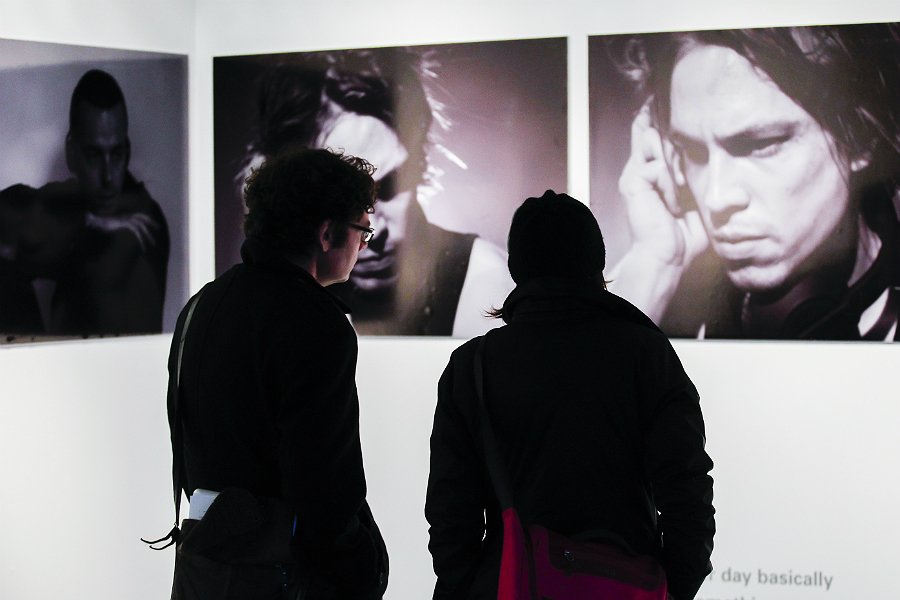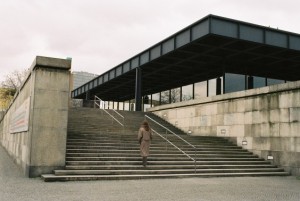The Big Interview:
Antony Hudek

Heard about the great new gallery space dedicated to the research of exhibitions? ERC curator Antony Hudek shows us round …
The Exhibition Research Centre (ERC), nestled within Liverpool School of Art and Design, is the first academic centre devoted to the study of exhibitions in the UK. Quietly producing two excellent and confident exhibitions since the start of the year, the arts space is open to the public, but as yet flying somewhat under the radar.
We met up with ERC ‘Initiator/Convenor’, LJMU lecturer and Tate Liverpool Reseach Curator, Antony Hudek, at his studio at LSAD to see what he’s got planned …
The Double Negative: Hi Antony! What is the ERC and why is it here?
Antony Hudek: Originally the space was intended as an art supply shop, and when that didn’t work out, it was more or less abandoned. Over the years there’s been some activity and exhibitions held here, but only sporadically. The idea when I was hired was to think of a space not just as an exhibition space per se, but as a space for experimenting with curatorial methods and for studying the history of exhibition making. It’s slightly different … it has all the trappings of a gallery space, but I think hopefully over time will emerge as a space that is more interested in exhibition practices. And that’s not to the detriment to the art. There are a lot of exciting exhibition spaces in Liverpool already, so it doesn’t need another one; what the university can bring is a kind of remove, to look at the structures, histories, theories and practices of display.
The ERC’s inaugural Keynote Lecture Series is entitled ‘The Kunsthalle Effect’ – exploring this movement of non-conventional art spaces, its history and its future. Why?
The simple reason is that the Kunsthalle model – the idea of a non-collecting contemporary arts space – although now over one hundred years old, hasn’t been studied closely. Museums and private galleries is as far as it’s gotten. In a way what we’re trying to do is render more complex the map of spaces that show and produce contemporary art. There are interesting genealogies, and I think what this Centre could do is talk about spaces in the present, while trying to understand their archaeology or histories, and how we got to these particular spaces that are non-museums, non-galleries, not artist-run.

I think it’s relevant to Liverpool specifically, because Liverpool is both too big for a lot of independent spaces that live in its shadows, and too small to be the next Bilbao success story. It hovers between the local and the national … The lecture series is about understanding that there are other models of exhibition spaces, like the Kunsthalle, that are born in in-between places. Tensta Konsthall, the art centre that Maria Lind, one of the keynote lecturers, directs, is in a poor suburb of Stockholm, in the periphery, but has an international reach. The Kunsthalle model can inspire us to think outside of the museum – alternative space dichotomy, reminding us there are other ways of showing art.
How did the CS Leigh exhibition come about?
I’ve been interested in CS Leigh for quite a while, especially in the exhibitions he did in the 1980s in New York. If you looked into this period you’d come across his name quite frequently. It was important for the Centre to very soon, after Jacques Charlier who is a conceptual artist, feature a filmmaker. To show that the space is open to a lot of different kinds of people, that exhibitions are made not just by curators and artists. Inviting CS Leigh was important to signal that the space is open to filmmakers/writers who have spent time thinking about exhibitions, and that whatever they do now, say filmmaking in this case, is related to their curatorial practice. So it’s about expanding this idea of the curatorial. In the coming weeks we’ll be working with Patrick Henry and Imogen Stidworthy, who are curating a group show as part of LOOK13, and later this year with freelance curator who works with the Liverpool Biennial, Rosie Cooper. How far can we go in these different directions?
Will the Centre always be an experimental playground? Or will its long term plans change?
I think on the exhibitions front it’s important to keep it as open and as diverse as possible. At the moment it’s a fairly standard programme, each exhibition lasting six or seven weeks; in the future it will be interesting to show exhibitions that could last a day, or two weeks, or much longer. I’m working with Christian Oxenius, a doctoral student based at the University of Liverpool, whose thesis is on Biennials; I’m keen to invite him to programme a series of talks at the Centre. That’s what will make it survive – through solid research components.
Another important area that we’ll be looking at is creating a network of institutions concerned with exhibition histories; there are quite a few places in France, Germany, the Netherlands, US, Canada – it’d be good to start dialoguing with them.
Are there any extra pressures that come with running a gallery space within a university ? Do you have to argue in favour of some ideas or do you have free reign?
Eerily, the Centre has remained quite true to its original formulation; this is due to Juan Cruz (School Director), who has really been behind it, and to the support of faculty members. If it weren’t for their backing, this experiment would certainly not last or work, but it’s also the possibility of it not lasting that makes it interesting – in a research environment failure can be as instructive as success. The opening of the first show was attended by the Dean; it shows the school is interested in what may happen. So for the moment we are enjoying a sense of freedom.
CS Leigh: In Camera is open daily at LSAD until Friday 5 May
The next ERC exhibition, Blackout (as part of LOOK13), opens on Light Night Friday 17 May 5-7pm





